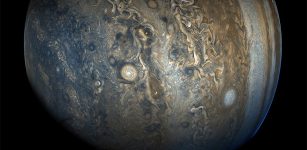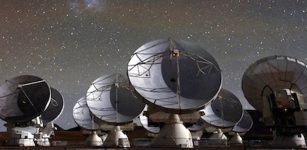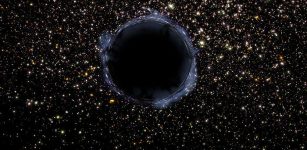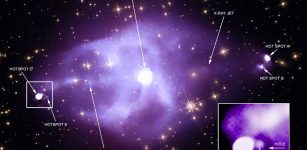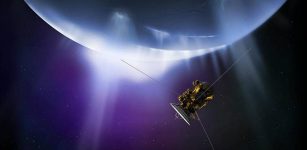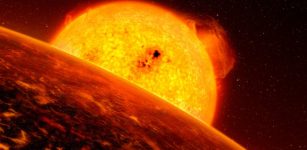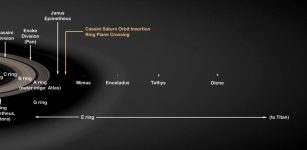New Telescope Will Detect Gravitational Wave Events
Eddie Gonzales Jr. – MessageToEagle.com – A new telescope, made up of two identical arrays on opposite sides of the planet, will track down sources of gravitational waves.
Credit: Monash University
The Gravitational-wave Optical Transient Observer (GOTO), led by the University of Warwick, signals a new era of gravitational wave science. Deployed across two antipodal locations to fully cover the sky, GOTO will scour the skies for optical clues about the violent cosmic events that create ripples in the fabric of space itself.
GOTO began when the UK’s University of Warwick and Australia’s Monash University wanted to address the gap between gravitational wave detectors and electromagnetic signals. Now the international collaboration has 10 partners, six of which are in the UK. GOTO has received £3.2 million of funding from the Science and Technology Facilities Council (STFC) to deploy the full-scale facility.
“This is really encouraging from an international cooperation perspective that the UK is willing to support this project, with new telescopes to be built in Australia,” said Associate Professor Duncan Galloway, from the Monash University School of Physics and Astronomy.
“The new site gives us a massive improvement in our chance to observe the counterparts of gravitational wave detections. Detecting the optical counterparts promptly is a key factor in how much we can learn from gravitational wave detections. The first such event, GW170817, was identified in 11hours; but our GOTO network can be on sky and autonomously observing the field within minutes.”
Long hypothesized as a by-product of the collision and merger of cosmic behemoths such as neutron stars and black holes, gravitational waves were finally detected directly by the Advanced LIGO (Laser Interferometry Gravitational-Wave Observatory) in 2015.
Since 2015, there have been many subsequent detections but, since observatories like LIGO can only measure the effects of the gravitational wave as it passes through our local patch of space time, it can be difficult to track down the source’s point of origin.
GOTO is designed to fill this observational gap by searching for optical signals in the electromagnetic spectrum that might indicate the source of the GW—quickly locating the source and using that information to direct a fleet of telescopes, satellites and instruments at it.
As most GW signals involve the merger of massive objects, these ‘visual’ cues are extremely fleeting as must be located as quickly as possible, which is where GOTO comes in. The idea is that GOTO will act as sort of intermediary between the likes of LIGO, which detect the presence of a gravitational wave event, and more targetable multi-wavelength observatories that can study the event’s optical source.
Professor Danny Steeghs of the University of Warwick, GOTO’s principle investigator, said: “There are fleets of telescopes all over the world available to look towards the skies when gravitational waves are detected, in order to find out more about the source. But as the gravitational wave detectors are not able to pinpoint where the ripples come from, these telescopes do not know where to look.”
Following the successful testing of a prototype system in La Palma, in Spain’s Canary Islands, the project is deploying a much expanded, second-generation instrument.
Two telescope mount systems, each made up of eight individual 40 cm (16 inch) telescopes, are now operational in La Palma. Combined, these 16 telescopes cover a very large field of view with 800 million pixels across their digital sensors, enabling the array to sweep the visible sky every few nights.
These robotic systems will operate autonomously, patrolling the sky continuously but also focusing on particular events or regions of sky in response to alerts of potential gravitational wave events.
Professor Steeghs continued: “The award of £3.2 million of STFC funding was critical in allowing us to build GOTO, as it was always envisaged to be; arrays of wide-field optical telescopes in at least two sites so that these could patrol and search the optical sky regularly and rapidly.
“This will allow GOTO to provide that much-needed link, to give the targets for bigger telescopes to point towards.”
In parallel, the team is preparing a site at Australia’s Siding Spring Observatory, which will contain the same two-mount, 16 telescope system as the La Palma installation.
The plan is to have both sites operational this year to be ready for the next observing run of the LIGO/Virgo gravitational wave detectors in 2023.
The optical search for gravitational wave events is the next step in the evolution of gravitational wave astronomy. It has been achieved once before, but with GOTO’s help it should become much easier.
If astronomers can locate convincing counterparts to gravitational wave signals, it will be possible to measure distances, characterize the sources, study their evolution and determine the environments they are formed in.
Written by Eddie Gonzales Jr. – MessageToEagle.com Staff




